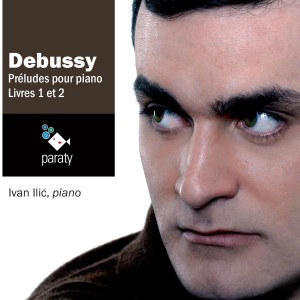
An ardent admirer of Frédéric Chopin, Debussy also left behind twenty-four Préludes for piano, collected in two books. Chopin’s Préludes represent, according to Harry Heilbreich, “arresting portraits of emotional states, rude awakenings of the surprised subconscious.” Debussy’s Préludes, on the other hand, are fleeting suggestions; he invokes swift, shimmering spirits.
The first book of Préludes was composed in the months from December 1909 to February 1910, and Debussy himself gave the premiere of four of them at the Société Musicale Indépendante on May 25th 1910, followed by four more on March 29th 1911. In January of 1911, Ricardo Viñes premiered three more Preludes at the Société Nationale. The Préludes of the second book were composed between 1910 and 1912, but the precise dates of their composition, as in the first book, are largely unknown. The order in which both books are usually played does not actually correspond to their chronology; Debussy himself had not arranged them in any particular order for publication. Incidentally, La Terrasse des audiences du clair de lune was the last Prélude, composed in December of 1912.
Placed at the end of each Prélude rather than at the beginning, the titles of the works help illuminate the composer’s imaginary universe. Some of them are borrowed from poets such as Baudelaire (Les Sons et les parfums tournent dans l’air du soir) and Leconte de Lisle (La Fille aux cheveux de lin); the name of the latter Prélude alludes to the sweet heroine from his opera Pélleas et Mélisande.
Among the primary themes in Debussy’s art are water, fog, landscapes, the sky, the world of fairies, exoticism, and Anglo-Saxon humour. Interestingly, the Préludes evoke a climate, an object or a visual impression, but human characters rarely figure among Debussy’s preoccupations. Also, there is only one Prélude that makes an explicit reference to piano technique: Les Tierces alternées is a toccata-like étude in the form of a ‘mouvement perpétuel’. On the other hand Feux d’artifice, full of sparkles, flares, and multicolour bouquets, and with its distant echoes of the Marseillaise, seems to follow in the tradition of the great transcendental technique of Liszt.
Many authors have remarked upon Debussy’s sensitivity to nature. He makes the sky shimmer in Les Collines d’Anacapri, whereas Des pas sur la neige unfolds on a “background of a sad, frozen landscape.” He makes the ocean move to a “caressing” rhythm, “without rigor” in Voiles and evokes the sweet sparkling of water in Ondine. A breeze shivers discreetly in Vent dans la plaine and the hurricane winds gust violently in Ce qu’a vu le vent d’Ouest, not by means of imitation, but by a musical transposition which surpasses the programme music of his forbears (and certain of his contemporaries). This transposition is achieved through rich and audacious technical means: whole-tone scales, modulations unrelated to the established key, the use of modal colouring, antiquated cadences, tremolos of seconds, and brief allusions to bitonality.
Danseuses de Delphes which Debussy played “with almost metronomic exactness” according to Marguerite Long, takes the form of a solemn Sarabande, inspired by a Greek bas-relief. Spain is also present, in La Sérénade interrompue where Debussy quotes Albeniz, and in La Puerta del Vino which has the rhythmic allure of a violently passionate habanera, inspired by a photograph of Alhambra of Grenada. The writing can be airy, or shrouded in a foggy mist (as in Terrasse des audiences du clair de lune, which quotes Au Clair de la lune), or somber and serene (Canope). There is transcendental brilliance (Feux d’artifice); there are also deliberately archaic references (Bruyères, La Cathédrale engloutie). The title La Cathédrale engloutie is a reference to the old Breton legend about the ruins of the city of Ys submerged by floods, which reappears at low tide.
Throughout, the music is enveloped in sumptuous harmonic and rhythmic refinements. They take on an almost voluptuous character in Les Sons et les parfums tournent dans l’air du soir, a title borrowed from one of the poems in Baudelaires ‘Fleurs du mal’ cycle which suggests the fragrances of the night. These refinements take on a buoyant quality in the arpeggios of Brouillards, they are slow and melancholic in Feuilles mortes, and they are transparent in the delicate scherzo Les Fées sont d’exquises danseuses, which end with a quotation from Weber’s Obéron. Elsewhere Debussy suggests “capricious and light” humour in La Danse de Puck, nervous and ironic characters in Minstrels and Hommage à S. Pickwick Esq., with its witty reminder of God Save the King, and evokes jazz “in the style and tempo of a Cake-Walk” in General Lavine – eccentric.
Placés par Debussy à la fin de chaque prélude et non au début, les titres, certains empruntés à Baudelaire (Les Sons et les parfums tournent dans l’air du soir) ou à Leconte de Lisle (La Fille aux cheveux de lin qui n’est pas sans évoquer la douce Mélisande), ont contribué à éclairer l’univers imaginaire du compositeur.

